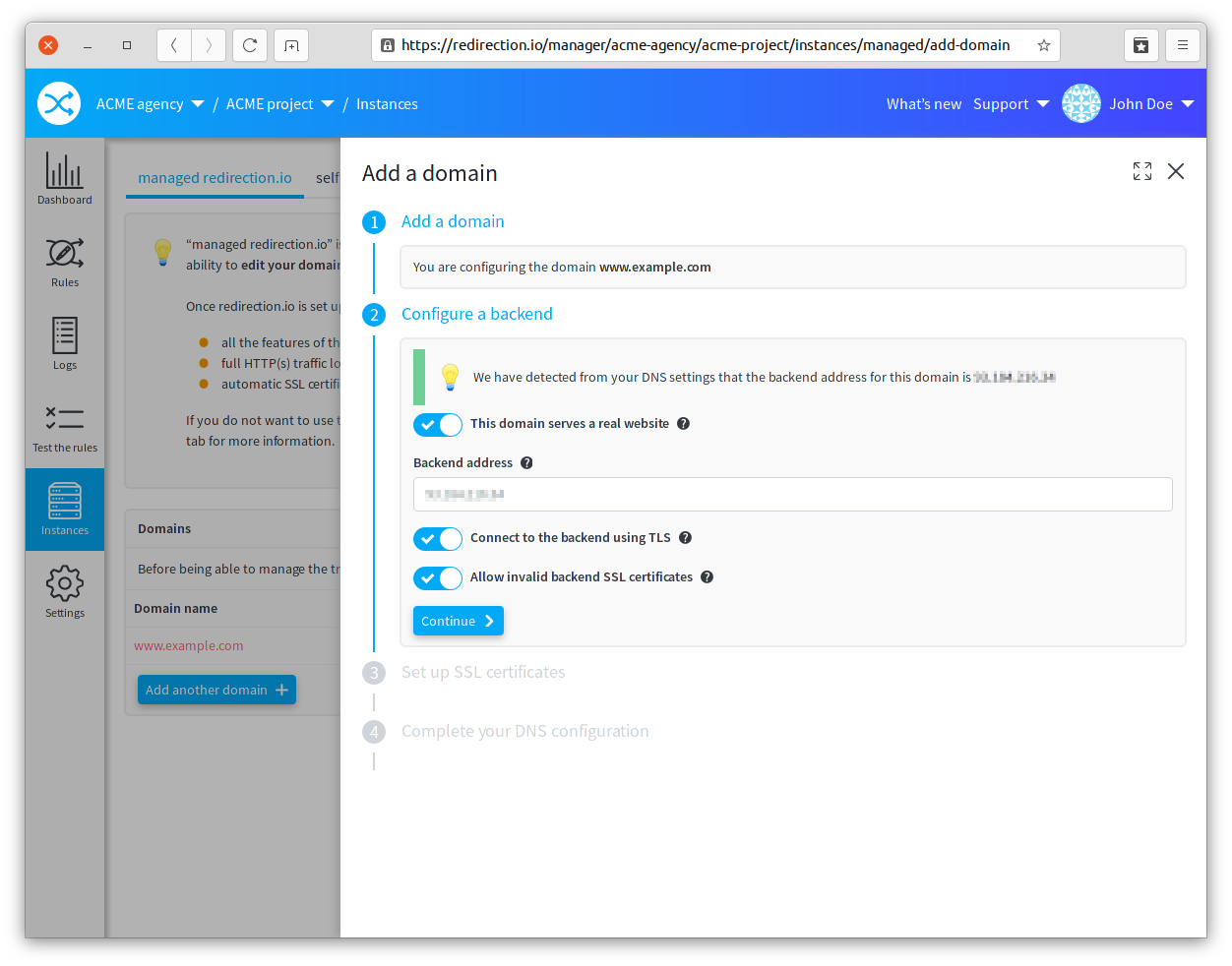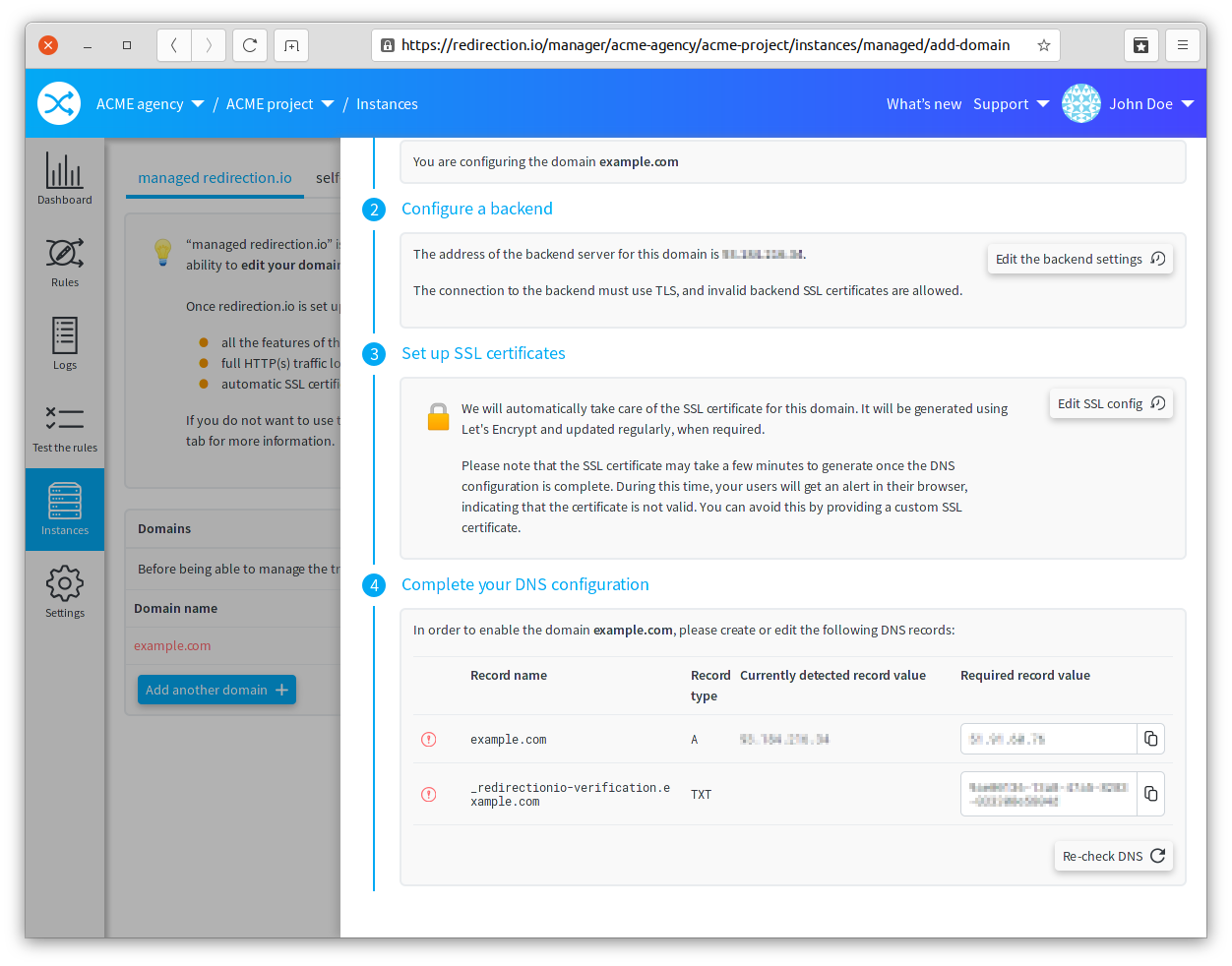Frequently asked questions
This page lists several frequently asked questions related to the managed redirection.io offer.
How long does it take to configure a managed instance in front of my existing website?
Configuring a redirection.io managed instance that proxifies traffic to an existing website involves several steps that only take a few minutes:
- create a redirection.io project
- upgrade to a paid plan (there's a 2-weeks free trial) in order to be allowed to proxify traffic of your website
- go the the manager's "instances" screen
- click on "Add another domain"
-

-

TXTverification record, then change theAorCNAMErecord) - click on "Re-check DNS"
Once we have ensured that the DNS records have been configured correctly, our infrastructure:
- starts up a node dedicated to your project in our various datacenters;
- then, uses Let's Encrypt services to generate a valid SSL certificate
These steps generally takes between 1 to 2 minutes, during which time your website will not be accessible. Once the SSL certificate is available, your website will be accessible again and you will be able to use all the features of redirection.io.
The documentation page "Add a domain to your project" gives detailed instructions on all the steps involved. We advise you to read it before starting the domain migration.
Is there a downtime when installing a redirection.io managed instance on my website?
Apart from the few of minutes mentionned above, no, there should be no downtime. Once redirection.io is installed, you can configure managed instances notifications in your project settings to be notified everytime an event occurs on your managed instance (certificate renewal, incorrect DNS settings, etc.).
Which are the managed instances proxification IP addresses used by redirection.io?
In our managed redirection offer, the redirection.io CDN acts as a reverse proxy infront of your infrastructure. In particular, this means that your backend server, which serves the content for your website, will see all incoming requests arrive from the redirection.io proxification nodes.
There is no specific affinity between a domain name and an ougoing IP address, which means that the requests your infrastructure will receive from us can come from several different IP addresses, depending on the location of the datacenter, the outgoing node that has been used, etc.
In certain cases, you may need to access the real user's IP address (access logging, etc.). The real user IP address is available using the X-Forwarded-For HTTP header, that our proxification infrastructure adds to the requests that are proxified to your backend servers.
It is bad practice to place blind trust in the value of this header, as it could be forged to mislead your platform and make you believe that the initial request comes from an IP different from its real origin.
This is why most Web servers or frameworks implement the notion of "Trusted Proxies", which allows you to whitelist a certain number of proxy server IP addresses, which will be the only ones for which your site will use the value possibly provided in the "X-Forwared-For" request header.
This mechanism is described in detail in the Mozilla Developer Network documentation.
We do not provide a fixed list of our managed instances outgoing IP addresses, as those may change on a regular basis. However, we provide a public API endpoint that lists the currently IP addresses used by our platform.
This list is available at the address https://api.redirection.io/ips
Check the detailed documentation for this endpoint.
What happens if the traffic of my website goes above the 100 GB monthly limit?
In order to provide a good service to all our customers, we have a fair use policy. If your website exceeds the 100 GB monthly limit, we will contact you to discuss the best solution for your website. We will never suspend your website without contacting you first.
When contacting you, we will provide you with information about your website's traffic in the form of an hourly spreadsheet for the last 30 days and a traffic diagram, which will help us determine your website's average traffic and the cause of the traffic spike.
If we conclude that the average traffic will remain above the allowed limits, we will suggest that you move up a level by buying more traffic.
Our Managed Instances Limits and Quota documentation gives details about our pricing for additonnal traffic volumes.